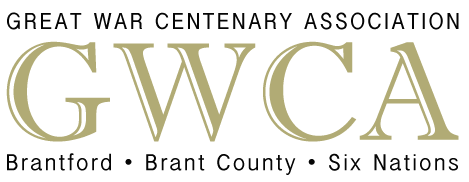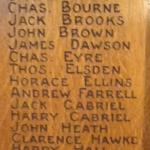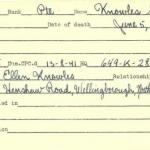BX September 10, 1915
Gassed at Givenchy, Private Knowles Returns – Broken in Health by Dastardly Warfare of Huns He is Home on Furlough to Recuperate in an Endeavor to Fit Himself for the Firing Line Once More.
Unheralded and alone, a Brantford hero of three battles relegated to the ranks of the discharged when his physical being was wrecked by the fumes of the deadly German gases. Pte. George Maurice Knowles stepped almost unnoticed from the morning G.T.R. train yesterday to spend the next few months at his home on Winnett Street, West Brantford. After helping to bury over a dozen of his comrades at Ypres on April 23, and after weathering Festubert on June 4, Pte Knowles was stricken down at Givenchy on June 8, when the suffocating gases enshrouded him. For eight hours he remained on the ground, helpless, until finally carried to the rear of the line where he received the kindest medical attention. After weeks of convalescing in Flanders and England, he secured his discharge and is now in Brantford on three months’ furlough, until December 8, when he must again present himself for examination, and if physically fit will return again to the trenches.
Boasting of eight years’ service with the Northampton Regiment in the Old Country and for three and a half with the Dufferin Rifles, Private Knowles was among the first to answer the call of Empire at the very outbreak of hostilities, leaving Brantford on August 22, under command of Capt. M.A. Colquhoun. Participating in the rigid preparatory training at Valcartier and Salisbury Plain, he left England in February for the firing line and was in the thickest of the fray at Ypres, where so many of his fellow soldiers were stricken from this world, while others were rendered useless for further service for many months. Pte. Knowles was among the comparatively few of the Brantford boys who got through the hail of bullets unscathed and remained in the firing line with his commanding officer and Lieut. Jones, who has since been promoted to the rank of major.
Although not so hard pressed at Festubert, Private Knowles went through another test of battle, again coming through the battle unwounded. At Givenchy, on June 8, at the same battle in which Lieutenant Ashton Cockshutt was wounded in the hand, developing later into blood-poisoning, Pte. Knowles was overcome by the frightful yellow gases, used so freely by the Huns.
He explained that the fumes seemed to sweep down and clutch the body in their grasp, choking off the air-supply and rendering the victim helpless. “It’s just like standing over a stove or chimney and have a gust of smoke sweep up in your face, and then trying to break into your lungs,” he explained as he tried to give some idea of the indescribable feeling experienced by the soldiers reached by the death-dealing gases.
For eight hours Pte. Knowles lay on the cold ground, awaiting his turn to be cared for. He was found and taken to Le Havre hospital, where every attention was kindly given to his needs. From Le Havre he was sent to Portsmouth, where he remained for several weeks, endeavoring to recuperate his health and strength. A few weeks ago he left for Shorncliffe, where after encountering many of the Brantford soldiers who had been wounded at Ypres and who were preparing to return to the firing line, he secured his discharge papers and sailed for Canada on the S.S. Metagama. Arriving at Quebec on Sunday last, Pte. Knowles was again subjected to a thorough medical examination and it was found that his throat and left lung had been seriously affected by the deadly fumes. His voice, too, is broken, and every word he utters bears the stamp of glory which he has gained in doing his bit at the front.
When asked if he were likely to return to the firing line, Pte. Knowles said that that would depend entirely on his ability to recover his strength. “If at the end of my three months’ furlough I’m fit to go back. I want to go. I want to go back again and help finish the job,” he added and as he asked The Expositor’s representative not to make too much of the few facts he had reluctantly related. He turned to get his old companion off the chair, his uniform which has accompanied him throughout all his experiences and has brought him safely back to his wife and home. Pte. Knowles was a shoemaker prior to his enlistment.


